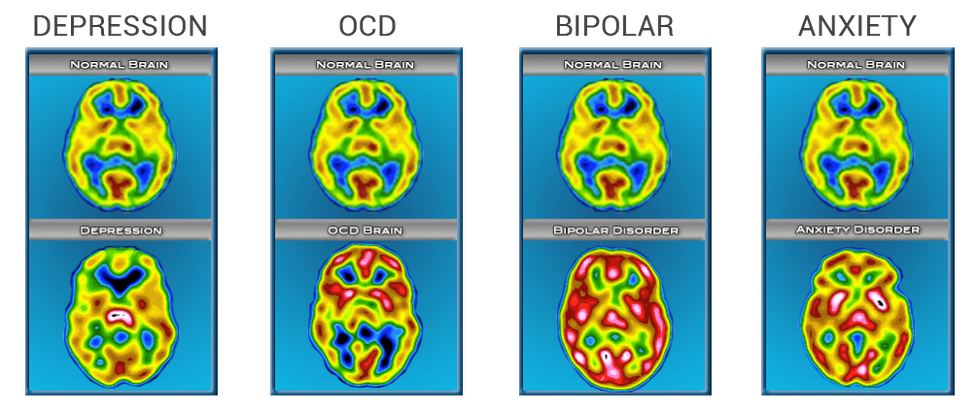Everyone has the capability of feeling worried, nervous, or anxious. It is completely normal to feel these emotions from time to time and everyone does. Anxiety is that jumpy, shaky feeling where all you want to do is get whatever is worrying you off your shoulders. It is common to feel “butterflies in your stomach” and for your heart to race, but the good thing is that these feelings go away rather quickly in the normal person. Once whatever you were worrying about is gone, these feelings disappear. For someone suffering the various forms of anxiety disorder, there is no off switch. These feelings of worry and angst are always there, either operating in the back of their mind or smacking them straight across the face. Because this disorder is usually invisible, no one knows when someone diagnosed with an anxiety disorder is struggling, and because it cannot be seen, it is much harder to believe in its significance as well. Anxiety disorder has a large significance too; it affects every aspect of the person’s life. It can ruin relationships, make education more difficult than it ordinarily is, it can keep people from leaving their homes, it can make people lose their jobs, and various other consequences which may result from the presence of this disorder. Even though some say it's not, anxiety disorder is a mental illness, and there is evidence to prove that it is.
Anxiety disorder is a long-term mental illness that causes people to feel overwhelming worry and/or fear in situations that are typically not dangerous. (NAMI) This may happen multiple times a day or not at all one day. It is a disease that is immensely hard to control without special techniques learned in therapy or medication. People feel tense and irritable, are restless and jumpy, experience a racing heart, shortness of breath, stomach aches, insomnia, tremors, headaches, diarrhea, and sweating. (NAMI) These symptoms vary in differing degrees in different people, but often plague the person’s life. Like these symptoms, anxiety disorder comes in many forms and not everyone suffers the same ones. The most common are panic disorder, phobic disorder, generalized anxiety disorder, and obsessive compulsive disorder. (Feldman) Panic disorder is characterized by panic attacks which are sudden overwhelming feelings of fright that makes the person feel chest pain, dizziness, stomachaches, and similar physical symptoms. (NAMI) Phobic disorder involves a heavy irrational fear of something that when the person is exposed to causes severe distress. (Feldman) Generalized anxiety disorder is a persistent intense feeling of worry that is felt all day about every aspect of life. (NAMI) Obsessive compulsive disorder is characterized by frequent intense thoughts (obsessions) and actions to satisfy those thoughts (compulsions). 40 million Americans have at least one of the forms of anxiety disorder. That is a good chunk of people who have such a strong mental illness that can negatively impact their lives. (NAMI) It is a disorder that is very persistent in all aspects of a person’s life. (Feldman) These multiple forms of anxiety disorder are very difficult and really tend to run the person’s life. That is such a large quantity of people who need help in some sort of way. The fact that anyone believes anxiety disorder is simply a behavioral wellness issue that can be easily fixed is ridiculous.
People have been known to never leave their homes, lose jobs, fail out of school, lose friends, spouses, and families all over this disorder. The terrible feelings of dread these people feel overtake everything else in their life and it becomes their main focus. Without treatment of some sort, a person can quite literally have their life ruined by something that they cannot even see and because it cannot be seen, it may seem like what they are fearing or worrying about is no big deal, but to them, it truly is the end of the world. They feel all they can do is run and hide. Most of the time, that is what they end up doing. The worst part is that no one quite understands what it feels like to have chronic anxiety. No one sees that the person is suffering 24 hours a day because of it. Sometimes, anxiety disorder makes a person so dysfunctional and it truly makes them wish they were anyone else but themselves. Unfortunately, some people do not take this mental health issue seriously and lives do become ruined and even end because of this disorder.
There are a number of people that believe anxiety disorder and similar mental illnesses like depression, post-traumatic stress disorder, and even schizophrenia are all flaws in behavior or are considered behavior wellness problems rather than issues caused by chemical imbalances in the brain and by genetics. (Folk) Granted, environmental factors over a long period of time can also cause chronic anxiety and the reason environmental factors can produce chronic anxiety is due to constant stress on the person, but that does not make it a behavioral problem. (Beyond Blue) The same people who believe that makes it a behavior issue sees anxiety disorder as something that can be easily fixed with a little education and effort. It is referred to as “problematic anxiety” and this problematic anxiety can be quickly improved by understanding what anxiety is and its effects on the body, getting professional help, and by actually applying changes to their life to fix these issues. (Folk) That sounds great and all, but it really is not that simple. If it were that easy of a fix, no one would be suffering from such disorders. Besides, most people diagnosed with anxiety disorder and other mental illnesses are explained to what it means to have such disorders when diagnosed by medical professionals and if they still are unsure, they do their own research. These are technology days and anyone can easily pull out their phone and google what it means to have any of the multiple forms of anxiety disorder. What they find, however, will be much different than those who believe chronic anxiety is a “learned behavior”. (Folk) These same people claim that feeling anxiety is no more a mental illness than feeling a normal emotion like sadness is. And for evidence, they state that everyone feels anxiety now and then. (Folk) Of course they are right if they were comparing it to the feeling of anxiety that is felt before anticipation of a nerve-wracking event, but not chronic anxiety that is felt all day and night for maybe no reason at all. Unfortunately, these people may agree that chronic anxiety is an issue and that it takes work to get rid of, but they clearly do not see the entire picture.
People claim that there is no medical proof that many mental illnesses are true diseases of the brain. (Loren) It is obvious that their research was not done however, because there has been a ton of research done on the professional level to prove that mental illnesses are exactly that. There is plenty of proof that shows mental illnesses are due to biological issues. For example, people with post-traumatic stress disorder and schizophrenia have been put through magnetic resonance imaging tests for doctors to see what the brain looks like after trauma and when the brain is damaged from schizophrenia. In both, the loss of brain matter can be seen. Similar to that, people with anxiety disorders and even depression produce brain scans that show a lot of different activity or a lack of activity in the brain compared to the normal idealistic brain. With physical proof like that, it is hard to deny the significance behind mental illnesses.
In addition to brain scans and MRIs, there is the observable behavior of a person before and after getting treatment for anxiety disorder and other mental illnesses that provide evidence of these disorders being caused by chemical imbalances in the brain rather than a learned behavior. More often than not, doctors prescribe medication to patients suffering from chronic anxiety. It takes a long time to find the right medication that works on that person, but once they finally find the one that works, the life of that person becomes completely different. The reason these medications work is for many cases of those with anxiety, the neurotransmitters, serotonin and norepinephrine, are too low in the brain. With medication, the brain can make serotonin and norepinephrine remain in their place and be used instead of just flushed out of the system like it does for normal people who do not need the excess. (Mayo Clinic) When these medications are used, people are given the opportunity to pick themselves back up. With the combination of therapy, techniques are learned and only make life easier to deal with for the person suffering anxiety disorder.
The final piece of evidence that supports anxiety disorder is a biological issue and not a behavioral flaw is that quite often, anxiety disorder and most other mental illnesses run in families. It is a genetic problem and environmental factors trigger it. (NAMI) It is common to see an anxiety-ridden mother have children with chronic anxiety too just as it is often seen that a father with asthma has children with asthma as well. Diseases, mental or not, are apt to run in families. Even if a mother and her son had never met, they are both very likely to suffer the same mental illness if it is present in their genetics. This is known because the research has been done. Twins that grew up in separate places can both be seen with the same mental illnesses because it all lies in their DNA. (Feldman) If anxiety disorder was a learned behavior, the chances of the results of this research being the same every time would be slim to none. And with anxiety disorder, people are apt to have other mental illnesses too. People with anxiety disorder have a large chance of having depression, ADHD, PTSD, developing an eating disorder, and substance abuse problems. (NAMI) With multiple mental illnesses being linked together, the evidence that anxiety disorder is a biological matter becomes stronger and stronger.
Knowing that brains scans and MRIs provide images that show the clear difference between the ordinary brain and a brain ridden with anxiety disorder, that medication and therapy are known for reducing and diminishing the effects of anxiety disorder, that anxiety disorder runs in families, and is linked to many other mental illnesses, it can be very heavily assumed that anxiety disorder is a mental illness too, a disease of the brain that negatively influences the everyday life. In fact, there is no better way to describe anxiety disorder in such few words. Anxiety disorder is something no one ever wants to feel, but it endlessly hangs over the sufferer’s head no matter what the situation. Unbelievably, some people find this disease to be simply a behavioral issue and fail to see it for what it truly is, a mental illness that must be fixed using medication and therapy. With there being plenty of evidence to prove these facts, it should be common knowledge that anxiety disorder along with many similar disorders are mental health issues that must be taken seriously. It is not right to call such diseases of the mind something so trivial and to undermine its effects on a person, for anxiety disorder is a mental illness that really can mess up lives if ignored. It is a long-term disease that causes 40 million Americans to feel overwhelming fears and worries for things that are not meant to be threatening. Knowing this makes it a substantial issue that must be evaluated a little more closely and treated more seriously.
Sources:
(including opposite side of the argument)
www.beyondblue.org.au/the-facts/anxiety/what-cause...
www.anxietycentre.com/anxiety/anxiety-a-behavioral...
http://slideplayer.com/slide/694325/
www.mayoclinic.org/diseases-conditions/anxiety/sym...
www.cchrint.org/psychiatric-disorders/behaviors-ar...
www.nami.org/Learn-More/Mental-Health-Conditions/A...
http://www.support22project.org/about.html (picture)
Feldman, Robert. Essentials of Understanding Psychology. McGraw-Hill Humanities/Social Sciences/Languages. 25 Oct. 2012.




















